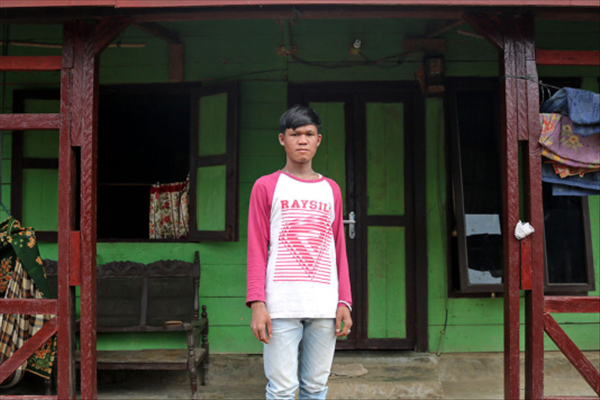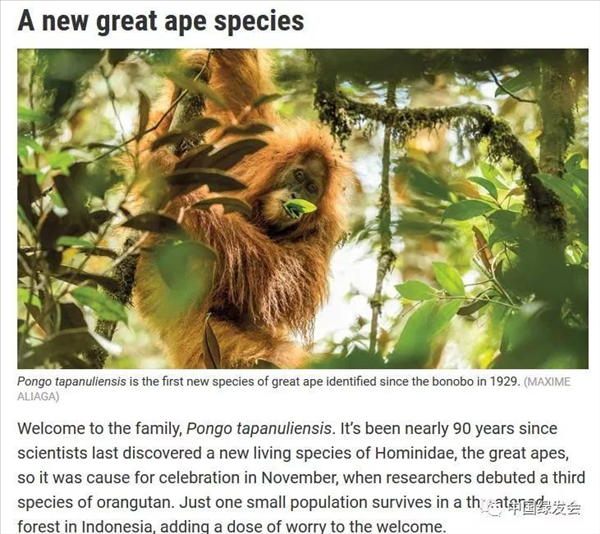- 收入总额:27103400.95元
- 支出总额:23122739.73元
- 爱心人次:2240次
编者按:2017年11月,绿会工作人员收到一封十分急迫的来信,这是一封来自印度尼西亚苏门答腊红毛猩猩的研究员的邮件。在此封邮件中,研究人员介绍了2017年刚刚成为独立新物种的打巴奴里红毛猩猩(Pongo tapanuliensis)的背景资料,以及它们的生活区域。打巴奴里红毛猩猩是生活在苏门答腊岛最南端的打巴奴里地区的猩猩种群。这些猩猩最近被定义为一个独立的物种。但因为现在还剩下800多只猩猩,它们已经自动成为世界上最濒危的猩猩物种。据研究员称,这片一片原始森林正在遭受一个水电大坝建设项目的威胁(510mw),这个水电站计划建立在打巴奴里红毛猩猩密度最高的地区,同时这片区域也是重建这个极受威胁物种的零散群体之间的连通性的关键领域。一旦建设起这个巨大水电站,对此种濒危物种继续生存下去造成严重威胁。
12月21日,世界顶级学术刊物《Science》期刊公布了2017年全球的十大科学突破,“科学家在印度尼西亚苏门答腊森林中发现新的猩猩物种——打巴奴里红毛猩猩(Pongo tapanuliensis)”名列第八,使得这个大坝建造项目更为国际社会广泛关注。正因此,最初打算投资此项目国际上某金融机构,了解到这个项目的生物多样性方面带来的负面影响以后,停止了参与。
生态环境、生物多样性保护,是我国2015年《推动共建丝绸之路经济带和21世纪海上丝绸之路的愿景与行动》纲领文件中3次高度强调的内容。2017年11月,主席曾明确指出,要开展绿色合作,建设文明之路。他深刻地指出,地球及其生态系统是人类共同的家园。要确立“全球共治、从我做起、刻不容缓”的环保意识,推动绿色投资、绿色贸易、绿色金融体系发展,调动一切可以调动的力量,积极为实现人与自然和谐相处、共建人类美好家园献策出力,推动丝绸之路成为一条绿色的文明之路。
濒危物种保护是中国绿发会的核心工作领域之一。为了响应中央关于社会组织走出去、服务“一带一路”与人类命运共同体的精神,因此,绿会十分关注这个消息,并且多方努力,尝试建立双方的有效沟通和对话。不过很遗憾的是,至今为止,我们的努力仍然石沉大海,尚未得到来自所涉投资方面的任何回应。
下面这篇文章,是国际上关于这个水电大坝项目的最新报道。虽有偏激和以偏概全之处,但它揭露的问题仍然是值得我国企业反思的。正所谓:“国之交在于民相亲,民相亲在于心连心”,我们认为,很多时候,民心相通、沟通和对话是必要的。就跟人与人之间的关系一样,两个人之间,如能有效沟通,让彼此了解为什么对方这样做、这样想,或许就能减少很多冲突、达成可行的妥协或折中方案。面对“一带一路”建设和生态环境造成的冲突,我们更应该总结经验,为未来的“一带一路”建设项目提供借鉴。为此,中国绿发会将此文翻译分享,作为我们“'一带一路'生态冲突研究案例库”的一个具体案例,供参考、点评、反思。
译/严莛棐 审+编者按/Linda 编/Angel
【案例库】"一带一路"建设项目生态冲突
【编号】EBRs-A003B
【时间】2017.11开始
【地点】印度尼西亚苏门答腊
WHY WE WROTE THIS
我们为什么写这篇文章
A project as sweeping as China’s multitrillion-dollar "Belt and Road" initiative has the potential to shake up global trade and geopolitics. But its toll on the environment may be just as significant.
一个全面的、价值万亿美元的中国“一带一路”倡议,具有撼动全球贸易和地缘政治的可能,但它对环境的影响可能同样值得关注。

Michael Holtz/Christian Science Monitor|Caption
迈克尔·霍尔茨/基督科学箴言报/说明
August 1, 2018
2018年8月1日
· By Michael Holtz Staff writer
· 由工作人员迈克尔·霍尔茨撰写
@michaelrholtz
BATANG TORU FOREST, INDONESIA
印度尼西亚,巴丹托鲁森林
Homles Hutabara grows solemn as he peers down at a large swath of clear-cut forest, the patch of exposed red-brown earth an ugly gash in the lush green landscape.
霍姆斯·哈塔巴拉庄严地俯瞰着脚下一大片被清场伐木的森林,一片裸露的红褐色土地在郁郁葱葱的绿色景象中呈现出一道丑陋的切口。
Gone are the rubber trees and oil palms that Mr. Hutabara’s family planted years ago to eke out a living in this remote corner of Indonesia. In their place stand a single-story prefab building and a small battalion of trucks and excavators. On most days, Hutabara says, the din of diesel engines drowns out the calls of gibbons and songbirds that once echoed through the trees.
消失的树林是几年前哈塔巴拉(Mr. Hutabara)先生一家种植的橡胶树林和油棕榈树林,他们以此在印度尼西亚这个偏僻的角落里维持生机。他们家矗立着一座单层的预制房屋、一辆小营卡车和一个挖掘机。在大多数日子里,哈塔巴拉说柴油发动机的噪声淹没了曾经在树间的长臂猿和鸣鸟的叫声。
“I miss hearing the sounds of the rainforest,” he says as he turns to return to his home. “When I come here now, all I hear are the sounds of big machines.”
“我想念能聆听雨林的声音,” 他转身往家走时说道, “现在当我来到这里时,我听到的只有大型机械的声音。”
The sounds serve as a nagging reminder of all that Hutabara and his family have lost. The area has been razed in recent months for the construction of a 510-megawatt hydroelectric dam on the Batang Toru River. The company in charge of the dam paid them for their farmland, but Hutabara says he’s still waiting for part of the payment, and has decided they didn’t receive a fair price, anyway.
这些声音犹如絮叨的提醒,警醒着哈塔巴拉和他的家人所失去的一切。近几个月来,为了在巴丹托鲁河(位于北苏门答腊省南部)上修建一座510兆瓦的水电大坝,该地区已经被夷为了平地。负责大坝的公司支付了当地人土地的损失费用,但哈塔巴拉说他仍在等待一部分的赔偿,并认为他与其他人无论如何都没有拿到合理的费用。
Some villagers want the see the dam canceled entirely. They’re joined by conservationists who warn that the project threatens to irreversibly alter Batang Toru's fragile ecosystem. Among the biggest concerns is that the dam could lead to the extinction of a newly discovered orangutan species that numbers only 800 animals. Then there is the risk of earthquakes – the project site is near a fault line – and the threat the dam poses to the livelihoods of some 100,000 people who live downstream.
一些村民希望看到这个大坝计划被彻底取消。他们被一些环保主义者召集了起来,这些环保主义者警告说,这个项目将会威胁巴丹托鲁河脆弱的生态系统,且造成无可挽回的影响。其中最让人担忧的是大坝可能导致新发现的——一种只剩下了800只的苏门答腊红毛猩猩(Pongo tapanuliensis)这一物种走向灭绝。除此之外,大坝还有导致地震的危险,由于项目地点接近断层线,大坝还可能威胁着下游的1万人的生计。

(来源:Science网站)
In fact, the risks are so great that the International Finance Corporation, the private-sector lending arm of the World Bank, reportedly declined to invest in it.
有报道说,建设这个大坝事实上风险很大,以至于一家国际金融公司,即世界银行私营部门的贷款机构,拒绝了投资这个项目。
But such concerns didn’t stop China from offering a helping hand. The $1.6 billion dam is being built by Sinohydro, a state-owned hydroelectric company, and is being paid for with Chinese loans. It has been folded into the “Belt and Road Initiative,” China’s multi-trillion dollar plan to fund infrastructure projects across Asia, Africa, and Eastern Europe.
但这种担忧并没有阻止中国伸出援助之手。这座价值16亿美元的大坝是由一家国有水电公司,中国水电(Sinohydro)建造的,并用中国贷款支付。它已被纳入 “一带一路倡议” ——一个中国的数万亿美元计划,其目的是为亚洲、非洲和东欧的基础设施项目提供资金。
The launch of the Belt and Road Initiative in 2013 has led to a worldwide building spree: from ports and power plants to highways and high-speed trains. Beijing has promoted the initiative as “win-win” for the countries that partner with it. But critics say that in the rush to sign new deals, many Chinese companies have been all too willing to ignore a wide range of risks, from social to financial – and especially environmental.
2013年开展的 “一带一路” 倡议引发了世界范围的建筑狂欢:从港口和发电厂到高速公路和高速列车。北京把 “一带一路” 的倡议提倡为与合作国家的 “双赢”。但批评家说,在急于签下新订单时,许多中国公司都非常愿意忽略各种风险,从社会到金融,尤其是环境上的风险。
William Laurance, an environmental scientist at James Cook University in Australia, has written that the Batang Toru dam is “merely the beginning of an avalanche of environmental crises” that the Belt and Road Initiative could trigger. An analysis published last year by the World Wildlife Fund found that the Belt and Road Initiative’s six major land-based corridors overlap with the ranges of 265 threatened species, including 81 endangered and 39 critically endangered species, and 46 biodiversity hotspots.
澳大利亚的詹姆斯库克大学(James Cook University)的环境科学家威廉姆·劳伦斯(William Laurance)写道,巴丹托鲁河大坝只不过是“一带一路倡议”可能引发的 “环境危机‘雪崩’的开始”。去年世界自然基金会(WWF)发表的一项分析发现,“一带一路”倡议的六大陆基走廊与265种受威胁的物种的范围重叠,其中包括81种濒危物种和39种极度濒危物种,以及46个生物多样性热点地区。
“This is emblematic of the kind of project that rational investors should not be touching,” Dr. Laurance says, referring to the dam, “and yet the Chinese are rushing in.”
“这是理性投资者不应该碰触的投资项目的典例,”劳伦斯博士谈到大坝时说, “然而,中国人却蜂拥而至。”
The newest great ape
最新的类人猿
Last fall, Beijing announced a series of environmental guidelines for overseas investments. But the guidelines aren’t legally binding, making environmentalists skeptical that Chinese companies will follow them. What’s more, many of the countries that are tied to the Belt and Road Initiative have notoriously lax environmental regulations. That includes Indonesia.
去年秋天,北京宣布了一系列关于海外投资的环境准则。但这些准则并不具有法律约束力,因此环保人士怀疑中国企业是否真的会遵循它们。更重要的是,许多与“一带一路”倡议有关的国家,都有着众所周知的宽松的环境法规,其中包括印度尼西亚。

Jacob Turcotte/Staff
雅各伯 · 特尔科特/工作人员
Dana Prima Tarigan, a regional director of the Indonesian environmental group Walhi, says that the environmental assessment conducted on behalf of the Batang Toru dam didn’t mention anything about earthquakes. It also didn’t mention how the dam would affect people living downstream. As a result of these omissions, Walhi is preparing to file a lawsuit against the project’s developer, North Sumatra Hydro Energy, and is calling on it to stop construction.
印尼环境论坛(Walhi)的地区主任达纳· 普瑞玛·塔里干(Dana Prima Tarigan)说道,代表巴丹托鲁大坝的环境评估没有提及地震。它也没有提到大坝会对下游的居民产生怎样的影响。作为这些评估遗漏的结果,印尼环境论坛正准备对该项目的开发商,苏门答腊北部水力发电公司(North Sumatra Hydro Energy)提起诉讼,并呼吁其停止施工。
Located on the island of Sumatra, Batang Toru is one of the most biodiverse ecosystems in Indonesia. The forest is home to the critically endangered Sumatran tiger, pangolin, and a new species of orangutan that was only identified last November.
巴丹托鲁位于苏门答腊岛,是印尼最具生物多样性的生态系统之一。这片森林是极度濒危的苏门答腊虎(Panthera tigris sumatrae)、马来穿山甲(Manis javanica)和一种仅在去年11月被发现的新品种红毛猩猩的栖息地。
Matthew Nowak, a biologist with the Sumatran Orangutan Conservation Programme who helped discover that the orangutan was genetically distinct, says they are already on the brink of extinction – and that the dam could push them over the edge.
马修·诺瓦克(Matthew Nowak)是一位苏门答腊猩猩保护项目的生物学家。他帮助发现新品种的红毛猩猩在基因上独特于其他品种,并称它们已经濒临灭绝——而且大坝可以把它们推入灭绝的深渊。
Once completed in 2022, the dam and its supporting facilities will occupy 2-1/2 square miles in the heart of the orangutans’ habitat. Mr. Nowak says that the infrastructure built to support it, namely access roads and high-voltage power lines, will make it virtually impossible to reconnect fragmented forests the species is spread across.
当大坝在2022年完成后,大坝及其配套设施将占据猩猩最重要的,范围2.5平方英里的栖息地。诺瓦克先生说,为支持它的基础设施,即连通公路和高压电力线,几乎不可能再重新连接物种四散生活的片段化森林。
“There are a series of forest blocs that, if you could connect them, you would have essentially a viable population of orangutans,” Nowak says. “If you don't connect them, you run the risk of pushing them rapidly to extinction.”
“这里有一系列的森林群落,如果你能把它们连接起来,你将有一个可以自行维持的猩猩种群,”诺瓦克说, “如果你不把它们连接起来,你就是在冒险——一个把它们迅速推向灭绝的冒险。”
Staying put
立足脚下
Local villagers have also vowed to fight. Over the past two years, they’ve banded together to hire a legal team and hold demonstrations at the construction site. They even flew to Jakarta last year to protest in front of the presidential palace.
当地村民也誓言要抗争。在过去的两年里,他们联合起来雇佣了一个法律小组,并在建筑工地举行示威活动。去年,他们甚至飞往印度尼西亚的首都雅加达(Jakarta),在总统府前提出抗议。
Downstream from the construction site, families that have depend on the Batang Toru River for their livelihoods also face an uncertain future. Fisherman Ruslim Zebua says runoff from a nearby gold mine has already made it difficult to make a living. He’s worried that by interrupting the river’s natural flow, the dam will make it even harder.
在建设工地下游,依靠巴丹托鲁河为生的家庭也面临着不确定的未来。渔民鲁斯琳·泽布(Ruslim Zebua)说,附近金矿的径流已经使他们难以生存。他担心大坝会阻断河流的自然流动,使生活变得更加困难。
“I’m not sure what I’ll do if the dam is built,” he says while sitting on bamboo bench next to the river. “I need to find a way to support my family.”
“我不确定大坝建成后我该做什么,”他坐在河旁的竹凳上说, “我需要找到一个方法来养活我的家人。”
Hutabara says he will never leave his home in the village of Gunung Hasahatan. His family has lived there for generations, and his ancestors lie buried in an overgrown cemetery on the edge of the forest.
哈塔巴拉则说他永远不会离开在哈萨哈坦山村的家。他的家人已经在那里生活了好几代,而且他的祖先还被埋葬在森林边缘的一个杂草丛生的墓地里。
“I have to stay here to look after their graves,” he says. “I wish that the forest would go back to the way it was before, but that’s hard to imagine.”
“我必须留在这里照顾他们的坟墓,”他说, “我希望森林能回到过去的样子,但这真的很难想象。”
(注:本文不代表译者观点。请批判性看待)
译/严莛棐 审/Linda 编/Angel
【原文链接】


